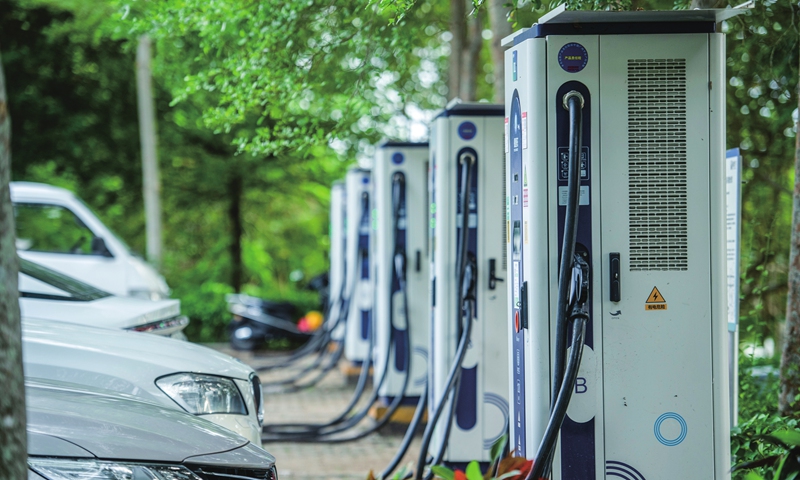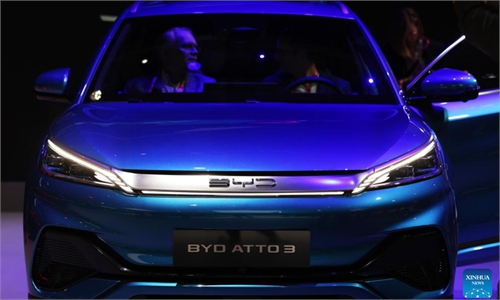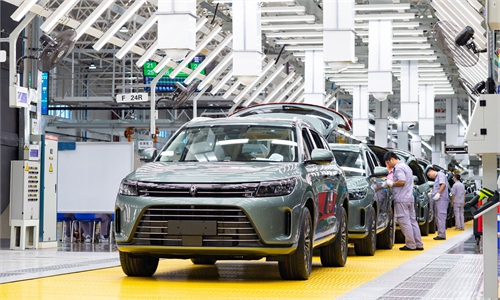
Newly installed charging piles for new-energy vehicles are seen in Jiaji town, South China’s Hainan Province on August 22, 2022. The island province unveiled an action plan for peak carbon on the same day, under which Hainan will entirely ban sales of fossil fuel vehicles by 2030. Photo: cnsphoto
In China, the world’s largest auto market, the new-energy vehicle (NEV) sector has stepped up rapid development over recent years as the country vows to upgrade green transport, but there is still an unbalanced landscape in a big country with varied climate patterns and terrains.
In North China, where temperature can fall to minus 20 C in winter, NEVs might become a headache for the owners due to reduced mileage and inconvenience in battery charging.
Huang, a BYD electric vehicle owner based in Hohhot, North China’s Inner Mongolia Autonomous Region, told the Global Times that the range of his car shrinks by half in the winter season from standard 500 kilometers to only 200 kilometers.
“I have to charge it frequently, but my apartment lacks the infrastructure to install a private charging pile, so it is a big headache for me facing cold weather,” Huang said.
According to tests by car information app Dongchedi on 60 models of mainstream EVs in winter under the temperature of minus 15 C, their average range could reach only 48.5 percent of the officially announced mileage by automakers.
“Cold weather is not friendly for batteries and inner-car air conditioning would intensify electricity consumption, which explains EV’s slow penetration in northeastern China and northwestern China,” Cui Dongshu, secretary general of the China Passenger Car Association told the Global Times, adding that automakers and battery manufacturers need to ramp up efforts to improve battery performance in extreme weather.
Northwestern and northeastern China rank as the two lowest areas in terms of EV penetration rate with 15.39 percent and 9.73 percent, respectively, far less than the average 25.22 percent across the country, according to statistics from Gasgoo.com, an auto industry site.
Apart from the decreased range, charging infrastructure in the north lags far behind the warmer south.
Feng, a Tesla owner based in Shanghai, told the Global Times that he has no worry about charging when he travels in provinces near Shanghai like East China’s Jiangsu and Zhejiang. But when he took the highway journey to his hometown in Changchun, capital of Northeast China’s Jilin Province, lack of available charging piles would give him more pressure.
“I have to plan my route in advance, to follow the path with the most charging piles as I can,” Feng said.
As of September 2022, South China’s Guangdong Province, the economic hub, had built China’s largest electric vehicle charging network, including 345,126 public charging piles and 19,116 charging stations, according to data from the China Electric Vehicle Charging Infrastructure Promotion Alliance (EVCIPA).
“The infrastructure construction for NEVs in northern China especially in the less developed cities could not follow the pace of the burgeoning NEV industry, which is not a new problem and it could be resolved, ” Cui said.
Taking Jilin as an example, the province is seeking to deploy 500 EV charging, battery swap stations and 10,000 charging plies by 2025, to meet demand of more than 100,000 units of EVs, according to the province’s 14th Five-Year Plan on energy.
Data from the China Association of Automobile Manufacturers showed that China’s NEV sales came in at about 6.89 million units in 2022, skyrocketing 93.4 percent year-on-year. Their market share in China’s auto market reached 25.6 percent last year, up 12.1 percentage points from 2021.


